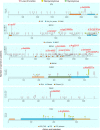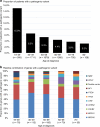Germline pathogenic variants of 11 breast cancer genes in 7,051 Japanese patients and 11,241 controls
- PMID: 30287823
- PMCID: PMC6172276
- DOI: 10.1038/s41467-018-06581-8
Germline pathogenic variants of 11 breast cancer genes in 7,051 Japanese patients and 11,241 controls
Abstract
Pathogenic variants in highly penetrant genes are useful for the diagnosis, therapy, and surveillance for hereditary breast cancer. Large-scale studies are needed to inform future testing and variant classification processes in Japanese. We performed a case-control association study for variants in coding regions of 11 hereditary breast cancer genes in 7051 unselected breast cancer patients and 11,241 female controls of Japanese ancestry. Here, we identify 244 germline pathogenic variants. Pathogenic variants are found in 5.7% of patients, ranging from 15% in women diagnosed <40 years to 3.2% in patients ≥80 years, with BRCA1/2, explaining two-thirds of pathogenic variants identified at all ages. BRCA1/2, PALB2, and TP53 are significant causative genes. Patients with pathogenic variants in BRCA1/2 or PTEN have significantly younger age at diagnosis. In conclusion, BRCA1/2, PALB2, and TP53 are the major hereditary breast cancer genes, irrespective of age at diagnosis, in Japanese women.
Conflict of interest statement
The authors declare no competing interests.
Figures


References
Publication types
MeSH terms
LinkOut - more resources
Full Text Sources
Medical
Research Materials
Miscellaneous

